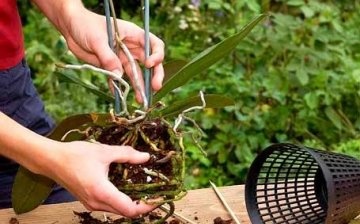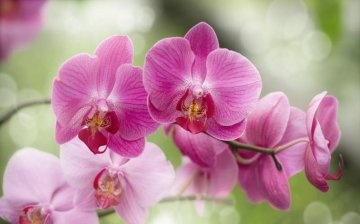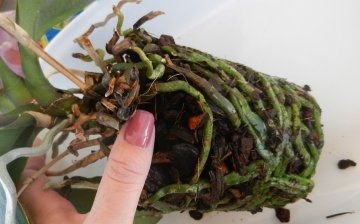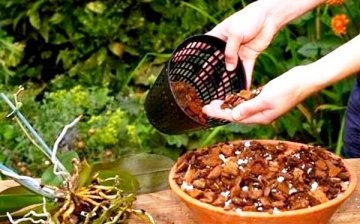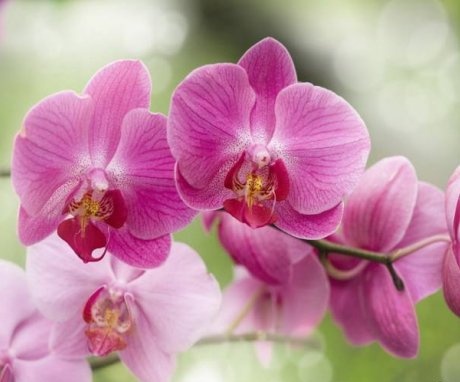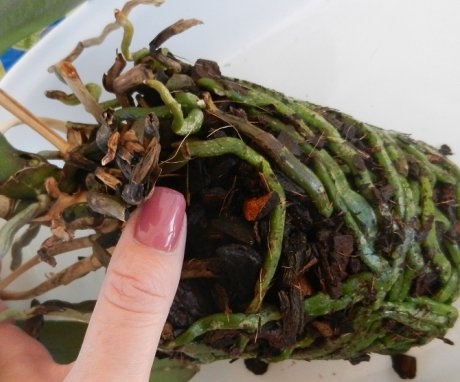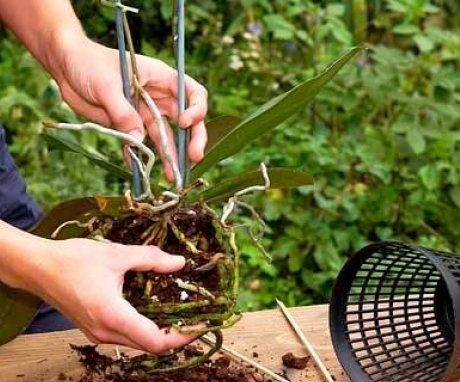Orchid, how to transplant - terms, rules and benefits
Orchid - one of the most exquisite, beautiful and amazing flowers, delighting flower growers with its unusual appearance and rich history. This plant is boldly referred to as royal and is placed on a par with a rose. Many are convinced that the orchid is superior in beauty to the queen of flowers. Indeed, the unique structure and unearthly beauty of the flowers make you subservient to the plant. Growing it always becomes an interesting process. After all, an orchid does not even need earth - it is an airy plant that requires a lot of air.
In the wild, you can find an orchid, braiding the trunk of a tree with its roots. And this is what she needs - not fertile land, but wood. Many botanists claim that the orchid is the peak of plant evolution. In order to successfully grow a beauty, a florist needs knowledge not only about caring for her, but also about her transplant. A short body of knowledge will help you find out all the nuances and features of transplanting this outlandish plant.
Content
- Orchid description
- Transplant: benefits and timing
- Preparing the substrate and flowerpot for the orchid
- Transplant process, features and nuances
- Post-transplant care rules
Orchid description
Orchid is a perennial plant that grows both on the ground and on trees and stones. Orchid shoots have different lengths depending on the species and variety. They can be short, medium or long - liana-shaped. Leaves are often thick, fleshy, but thin ones can also be found. Their color ranges from bright green to brown with a reddish tint.
You can find leaves with an element of the pattern - bright luminescent green stripes wriggling along the leaf. Seeing such a sight, you might think that the flower was dropped by aliens traveling across galaxies - the leaf is so unusual. Orchid flowers can be arranged singly or in inflorescences.
They range in size and shape from small to large, and the variety is amazing.
A distinctive feature of orchid flowers is the presence of a "lip" - a landing strip for insects. You will not find a pistil and a stamen in her, since they have grown together due to the evolutionary process - a "column" has appeared. Pollination of the plant occurs not only thanks to bees, but also flies, small birds and even bats. Many types of orchids have pseudobulbs, an organ for storage and water storage. They can be of different shapes, but more often oval or round.
The history of the origin of this unusual flower is very controversial. Some scientists argue that it has several million years of evolution, and some talk about several thousand. The unearthly beauty of orchids and its rich and interesting history make gardeners grow the plant and admire its unusual flowers. Proper care and timely transplantation allows orchids to grow for many years and delight with their sophistication.
Transplant: benefits and timing
Transplant the plant is needed once every two to three years. But if the florist sees that the orchid has outgrown the flowerpot, then you need to transplant it, regardless of how much it grows in this flowerpot.The benefits of transplanting are obvious. They allow the plant to develop further.
If the orchid is not transplanted, the following problems will appear:
- The roots will begin to rot due to the compaction of the soil. The bark decays over time and begins to compress. Less and less air gets in - this is the first and main unfavorable factor when growing orchids.
- The roots stop growing and begin to rot due to the lack of sufficient space in the flowerpot. They compress themselves, displace the soil.
- The decomposed soil does not allow water to thoroughly saturate the roots - this leads to drying out root system... The plant can die quickly.
Timely transplant will avoid these problems and save orchid... The optimal timing for transplanting is spring, but if you suddenly need to transplant it for some reason in another period of the year, transplant it. The main rule is the absence flowering.
Preparing the substrate and flowerpot for the orchid
Orchid substrate is prepared depending on the species. Epiphytic plants love a lot of air and moisture. They feed on organic matter. Therefore, the composition of the substrate will include pine bark, charcoal and sphagnum moss.
The process of preparing a substrate is reduced to the following stages:
- Pine bark must be boiled and crushed into pieces 1.5-2 cm in size for an adult plant and 0.5-1 cm for young rosettes.
- Moss follows process hot water - boiling water. That is, it is necessary to carry out heat treatment. However, many growers prefer to use live moss without any treatment. This option is also suitable.
- Further, all components - bark, moss and charcoal - are thoroughly mixed.
- For terrestrial orchids, the principle of preparing the substrate is slightly different. The following components should be used here: roots fern, pine bark and loose leafy ground. The ratio is 1: 1: 1. As a result, the substrate should perfectly absorb water, it should not linger on the surface. The bark and roots of the fern must also be heat treated.
It is better to select a new flowerpot for an orchid from such materials so that the roots do not stick to the walls. It can be plastic or glass. The flowerpot should be transparent, since the roots of the plant not only absorb air and moisture, but also participate in photosynthesis.
It is advisable to purchase a plastic, transparent container with side holes.
Before replanting the plant, the flowerpot must be doused with boiling water (glass) or treated with a weak solution of potassium permanganate (plastic). At the bottom of the pot, drainage is poured 2-4 cm in height. Drainage can be ordinary expanded clay. Having prepared the substrate and flowerpot, you can proceed to transplant.
Transplant process, features and nuances
In the process of transplanting, the florist must take into account the fragility of the root system. orchids... In this regard, a whole orchid transplant system has been developed, which allows you to minimize the risk of damage.
The whole process boils down to the following steps:
- An old pot with a plant is immersed in a container of water for several hours. This is done so that the substrate swells and the roots calmly move away from the walls of the pot and bark.
- After the plant is carefully, without haste, pulled out of the pot. Experienced gardeners recommend rinsing off adhered substrate with a shower and warm water. Gently spill the roots, if some particles of the bark do not leave, it's okay - leave them.
- Examine the root system. Brown areas (rot) should be cut off with a sharp knife at an angle. Cutting points are treated with crushed charcoal or activated carbon.
- Next, the orchid is left to dry for a day. During this period, the wounds will heal, and the root system will dry out. If you plant a plant right away, the roots can rot and the orchid will die.
- A day later, you can plant the plant in a new flowerpot.When transplanting, take into account this moment - the root collar of orchids should not burrow into the substrate.
If you follow all these simple steps for transplant, the orchid will quickly recover after the procedure and begin to bloom. However, if the roots were damaged in the process, acclimatization will take a long time and flowering can occur only in the second year after transplantation.
Post-transplant care rules
Immediately after transplanting, the plant is not watered for 2-3 days. This is all done with the same purpose - to avoid root rotting. After two days, the orchid can be watered in the following way: the flowerpot is immersed in a container of water for two to three hours. After that, you can go to the usual way. glaze... During the growing season, the plant must be fed with complex fertilizersdesigned for orchids.
Top dressing is applied twice a month in summer and once a month in winter. In winter, it is better to keep the plant closer to cold windows, on the windowsill, it is under such conditions that future flower buds are laid. Always keep an eye on humidity and light orchids.
Water should not accumulate in the flowerpot, otherwise the roots will rot.
Direct rays of the sun should also not hit the delicate inflorescences and leaves of orchids. All these simple recommendations and rules for transplanting will help the grower to preserve his beloved beauty and stimulate her growth. Already in the second year after transplants the orchid will reciprocate and begin to delight with flowers of unearthly beauty.
More information can be found in the video.



